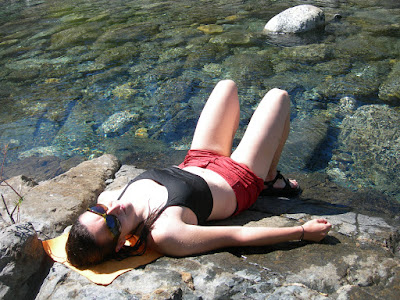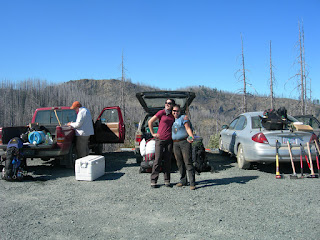 |
| The Chetco River's "magic canyon" below Carter Creek |
 |
| Boaters on their way up the Babyfoot Lake Rim on the Trans-Kalmiopsis Route |
In recent years, various groups of boaters have made it into the Chetco and have come
back with stories of a beautiful canyon, quality whitewater, and crystal clear water. The
Chetco remains, however, one of the most difficult trips in Oregon to accomplish. But the
most challenging part of a Chetco trip isn’t the whitewater - it’s getting to the whitewater.
If it wasn’t already a brutal task, the 2002 Biscuit Fire's aftermath of falling trees made
the challenge even tougher. Thousands of fire-killed trees stacked in seasonal layers
have made access from Chetco Pass to Slide Creek via Upper Chetco Trail No 1102
impassable.
 |
| Bailey Mtn Trail No 1109 to Carter Creek confluence |
Now the most convenient access is at the Carter Creek
confluence via the Trans-Kalmiopsis Route. That's a 9-mile hike from Babyfoot
Lake.
Siskiyou Mountain Club volunteers have been working for the last three
years to keep the onslaught of falling trees and new brush at bay, and
ambitious boaters unafraid of a long, tough hike have been using it to launch
their trips.
Boaters
who want to help keep the route open in 2013 should join the Club over the
three-day Memorial Day weekend (May 25 – 27, 2013). - Meet and network with other boaters who share an interest in running the Chetco
- See first-hand what trail conditions are like to get into the Chetco
- Familiarize yourself with the logistics of running the Chetco
- Learn backcountry tips from seasoned Kalmiopsis trail crew leaders
The
Club provides leadership, tools, food and help with transportation. You provide
some basic gear.
Worth the
read:
- Trip report from boater Brian Vogt
- Oregon Field Guide, Chetco River Revisited
- Kalmiopsis, project info
- Trip report from outfitter Zach Collier







































